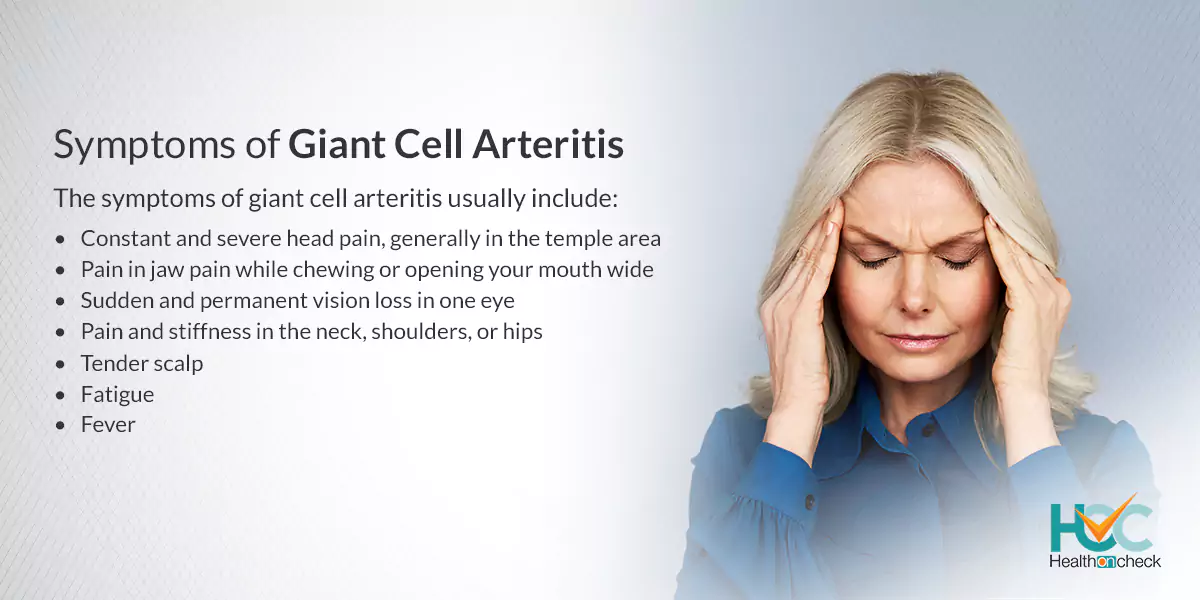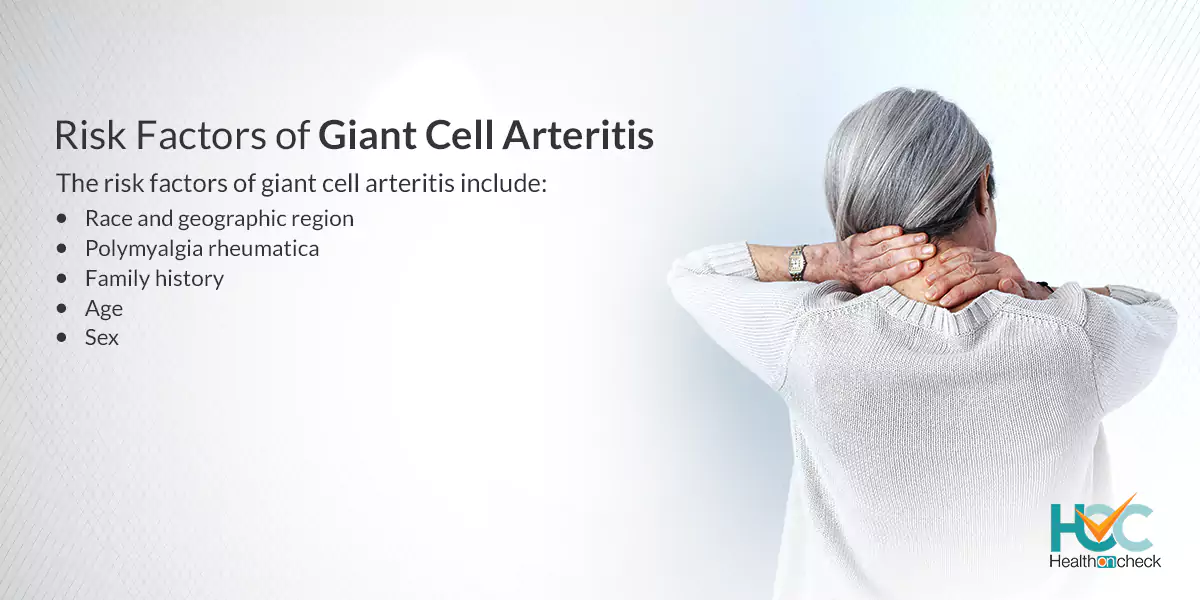What is Giant Cell Arteritis?

Giant cell arteritis, also known as temporal arteritis, is an inflammation of the blood vessels, a form of vasculitis. If you have this condition, then your temporal arteries (the blood vessels adjacent to the temples), supplying blood from the heart to the scalp, become swollen (inflamed) and narrowed (constricted). The vasculitis that causes temporal arteritis might involve other blood vessels, including the posterior ciliary arteries which can even cause blindness, or large blood vessels such as the aorta and its branches, which can cause various severe health complications.
What are the Types of Giant Cell Arteritis?
The signs and symptoms of giant cell arteritis can be classified into two subsets:
– Cranial arteritis
It’s believed that it occurs because of a faulty immune response and has been linked to some infections and certain genes.
– Extracranial arteritis
It’s identified by inflammation of large- and medium-sized arteries, which usually affects the external carotid artery and its branches, particularly the superficial temporal artery.
What are the Symptoms of Giant Cell Arteritis?
Head pain and tenderness — usually severe are the main signs and symptoms of giant cell arteritis generally affecting both temples. Head pain can gradually get worse which comes and goes, or temporarily subside.
The symptoms of giant cell arteritis usually include:
– Constant and severe head pain, generally in the temple area
– Tender scalp
– Pain in jaw pain while chewing or opening your mouth wide
– Fever
– Fatigue
– Unintended weight loss
– Double vision or vision loss
– Sudden and permanent vision loss in one eye
– Pain and stiffness in the neck, shoulders, or hips
What are the Causes of Giant Cell Arteritis?
When you have giant cell arteritis, the lining of arteries becomes inflamed, resulting in them swelling. This swelling narrows your blood vessels because of the swelling, which decreases the amount of blood and hence blocks the flow of oxygen and vital nutrients to your body’s tissues.
Giant cell arteritis can affect almost any large or medium-sized artery, but the arteries in the temples are usually swollen and are placed just in front of your ears to your scalp.
The reason why these arteries become inflamed isn’t clear but it’s believed that it is because of the immune system abnormally attacking the artery walls. Some particular genes and environmental factors may also raise your susceptibility to giant cell arteritis.
What are the Risk Factors of Giant Cell Arteritis?
The risk factors of giant cell arteritis include:
– Age
Children are not affected by giant cell arteritis and it occurs in adults only, and people under 50 are rarely affected by it. Most people between the ages of 70 and 80 are affected by it.
– Sex
Women are about two times more prone to this condition as compared to men.
– Race and geographic region
Though people of any race can get this condition white people in Northern European populations or of Scandinavian descent are more prone to it.
– Polymyalgia rheumatica
People with another condition called polymyalgia rheumatica have an increased risk of developing giant cell arteritis.
– Family history
If you have a family history of giant cell arteritis, then you have an increased risk of developing it.
What are the Complications of Giant Cell Arteritis?
Giant cell arteritis can lead to some serious complications, including:
– Blindness
This condition can lead to reduced blood flow to your eyes which can result in a sudden, painless loss in one or both eyes (rarely)which is permanent.
– Aortic aneurysm
The formation of a bulge in a weakened blood vessel, generally in the large artery running down the middle of your chest and abdomen (aorta) is called aortic aneurysm which is a complication of Giant cell arteritis and it may burst and can lead to fatal internal bleeding.
– Stroke
Though rare, people with this condition might get strokes also.
How Giant Cell Arteritis is Diagnosed?
It can be difficult to diagnose giant cell arteritis due to its early symptoms resembling other similar conditions. Because of this, your doctor will first try to rule out other possible reasons for your condition. The most important factor in diagnosing this condition is the patient’s medical history which makes the doctor consider the diagnosis. After going through the patient’s medical history, your doctor will carry out a physical examination and examine whether the patient’s pulse is weak. After that, the patient’s head is also checked to detect scalp tenderness or swelling of the temporal arteries.
Blood tests, including erythrocyte sedimentation rate and C-reactive protein, are prescribed, for measuring the level of inflammation (swelling)in the body. The doctor will check the anaemia by measuring the haemoglobin level (the part of red blood cells that carries oxygen).
Other tests that can help to diagnose giant cell arteritis include:
– Magnetic resonance imaging (MRI)
In this procedure, a huge magnet, radio waves, and a computer are used to produce sharp images of the body.
– Positron emission tomography (PET) scan
In this procedure, a very low dose of a radioactive chemical is injected into the vein of the arm which is then followed on a PET scanner through three-dimensional images for diagnosing giant cell arteritis.
– Ultrasound
High-frequency sound waves are sent through body tissues and the resulting echoes are recorded and turned into images of the inside of the body.
Biopsy
A biopsy is the best way to confirm a diagnosis of giant cell arteritis. Here a small sample (biopsy) of the temporal artery is taken from your body and sent to a lab for examination under a microscope. This artery is located near the skin just in front of your ears and continues up to your scalp. This procedure is carried out on an outpatient basis by using local anaesthesia, generally with little scarring or discomfort.
In case you have giant cell arteritis, the artery will usually show inflammation including unusually big cells, known as giant cells.
If the results aren’t clear, your doctor may go for one more temporal artery biopsy on the other side of your head.
What are the Treatment Options Available for Giant Cell Arteritis?
Even though there is no cure for giant cell arteritis, the symptoms can be controlled and managed with medications. This condition should be treated as soon as possible to avert further damage that occurs due to poor blood flow.
Giving high doses of a corticosteroid drug including prednisone is the primary treatment for this condition. Giant cell arteritis can cause vision loss which can be permanent so immediate treatment is necessary to prevent it even if the diagnosis with a biopsy is not confirmed.
Within a few days of starting treatment, you will likely start to feel better but in case you have a loss of vision before beginning treatment with corticosteroids, it’s unlikely that your vision will improve. But your unaffected eye may be capable of compensating for a few of the visual changes.
You might be required to continue taking medication for 1-2 years or even longer. After the first month, your doctor may slowly start to reduce the quantity of the dosage until you reach the lowest dose of corticosteroids required to control inflammation.
Some symptoms, especially headaches, might recur during this tapering period, and at this point, many people start to develop symptoms of polymyalgia rheumatica. Such flares can generally be treated with a little increase in the dose of corticosteroid. dose. You might also be suggested an immune-suppressing drug called methotrexate (Trexall) by your doctor.
Corticosteroids might cause some serious side effects, including high blood pressure, osteoporosis, and muscle weakness. To counter the potential side effects, your bone density is monitored by your doctor and he/she may prescribe vitamin D and calcium supplements or other medications to avert bone loss.
Sometimes tocilizumab (Actemra) is also prescribed to treat giant cell arteritis which is given as a form of injection under your skin.
Living with Giant Cell Arteritis
The results of treatment for this condition are quite satisfactory unless there is a loss of vision. If it happens, the damage usually cannot be reversed. Most complications linked with giant cell arteritis occur because of the steroid drugs, and not from the disease itself.
Whom to Consult?
If you notice a new, continuous headache or any of the signs and symptoms of giant cell arteritis then you should consult with your doctor as soon as possible because delayed treatment can cause permanent vision loss in one eye.






